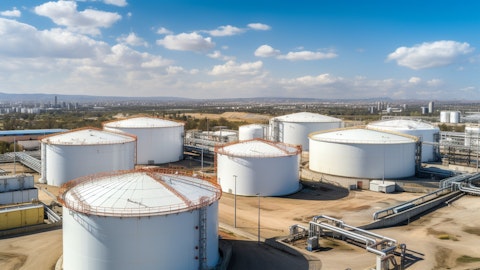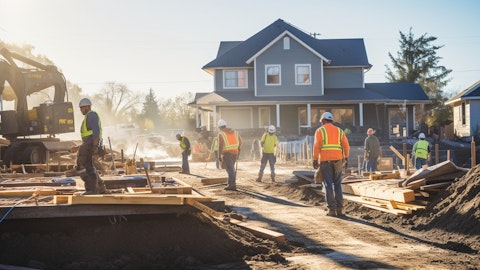SPX Technologies, Inc. (NYSE:SPXC) Q1 2025 Earnings Call Transcript May 1, 2025
SPX Technologies, Inc. beats earnings expectations. Reported EPS is $1.38, expectations were $1.16.
Operator: Good day, and thank you for standing by. Welcome to the First Quarter 2025 SPX Technologies Earnings Conference Call. [Operator Instructions] Please be advised that today’s conference is being recorded. I would now like to hand the conference over to your first speaker today, Paul Clegg, Vice President of Investor Relations. Please go ahead.
Paul Clegg: Thank you, operator, and good afternoon, everyone. Thanks for joining us. With me on the call today are Gene Lowe, our President and Chief Executive Officer; and Mark Carano, our Chief Financial Officer. A press release containing our first quarter results was issued today after market close. You can find the release and our earnings slide presentation, as well as a link to a live webcast of this call in the Investor Relations section of our website at spx.com. I encourage you to review our disclosure and discussion of GAAP results in the press release and to follow along with the slide presentation during our prepared remarks. A replay of the webcast will be available on our website. As a reminder, portions of our presentation and comments are forward-looking and subject to safe harbor provisions.
Please also note the risk factors in our most recent SEC filings. Our comments today will largely focus on adjusted financial results and comparisons will be to the results of continuing operations only. You can find detailed reconciliations of historical adjusted figures from their respective GAAP measures in the appendix to today’s presentation. Our adjusted earnings per share exclude amortization expense, acquisition-related costs, nonservice pension items, mark-to-market changes and other items. Finally, we will be meeting with investors and various events over the quarter, including the Oppenheimer Industrial Growth Conference on May 8, the BofA Securities, Industrial, Transportation and Airlines Key Leaders Conference on May 14, the Wolfe Research Small and Mid-Cap Conference on June 3, and the William Blair Growth Stock Conference on June 4.
And with that, I’ll turn the call over to Gene.
Eugene Lowe: Thanks, Paul. Good afternoon, everyone, and thank you for joining us. On the call today, we’ll provide you with an update on our consolidated and segment results for the first quarter of 2025, as well as an update on our full year outlook. We had a strong start to the year. We grew first quarter adjusted EBITDA by 12% and adjusted EPS by 10%. Our company continued to execute well, driving strong margin performance across both segments and making progress on several key initiatives. Recently, we made another attractive addition to our HVAC segment with the acquisition of Sigma and Omega, which enhances the value we provide to customers in our HVAC segment while positioning us for further growth. Today, we’re raising our full year adjusted EPS guidance range to reflect our strong Q1 and the acquisition of Sigma and Omega, partially offset by the impact of the current tariff environment.
We now anticipate growth in adjusted EBITDA of 15% at the midpoint of our range. Looking ahead, we remain well positioned to manage through a range of economic conditions. We have a high level of replacement sales and diverse demand drivers across our end markets. Our critical solutions are often government mandated, or required, and we have a strong playbook that has proven effective in adapting throughout the change. Turning to our high-level results. For the first quarter, we grew revenue by 3.7%, driven by a solid performance in our HVAC segment and the benefit of recent acquisitions. Adjusted EBITDA increased by approximately 12% year-on-year with 150 basis points of margin expansion. As always, I’d like to update you on our value creation initiatives.
We continue to leverage our business system to manage a dynamic tariff environment, remaining nimble and redeploying resources as needed. We are also closely managing price and our sourcing relationships to mitigate the impact of tariffs. During the quarter, we also continued to gain traction on our continuous improvement and value engineering initiatives. In our HVAC segment, we identified additional opportunities to standardize control components in our electric key products, allowing more streamlined manufacturing, shorter lead times and lower costs. In our Detection & Management segment, we continue to advance our new product initiatives. Our transportation platform introduced a new ticket vending machine called the Venstar 5, there’s a much smaller footprint, a larger screen and several advanced features that provide an enhanced user experience.
We’re receiving great customer feedback on the product and already seeing significant sales. In April, we continued to advance our inorganic growth initiative with the acquisition of Sigma and Omega, which enhances the value we offer our customers in our HVAC segment. Sigma and Omega’s product portfolio includes vertical stack heat pumps and fan coils, institutional heating products and self-contained units. These solutions are highly complementary with our existing HVAC businesses and expand our addressable market. They are often paired with cooling towers and boilers typically receiving approximately 2x the order value of the cooling tower boiler combined for this type of solution. The transaction is an excellent fit that creates significant opportunities for leveraging our combined channels to drive growth in attractive end markets, in particular, for multistory buildings such as hotels, schools hospitals and commercial and residential properties across North America.
Today, more than 2/3 of Sigma and Omega’s revenue comes from domestic sales to their Canadian customers. As a part of our value creation strategy, we plan to substantially increase sales to U.S. customers, supported by the expansion of production at our existing U.S. facilities with minimal additional capital investment. We’re very pleased with this transaction and are excited about Sigma and Omega joining the SPX team. Now I’ll turn the call over to Mark to review our financial results.

Mark Carano: Thanks, Gene. Our first quarter results were strong. Year-on-year adjusted EPS grew 10% to $1.38. For the quarter, total company revenues increased 3.7% year-on-year primarily driven by the acquisition of KTS in late January, and an extra month of Ingenia, which closed in early February of 2024. Consolidated segment income grew by $10.7 million, or 10.7%, to $110.5 million, while segment margin increased 140 basis points. The [indiscernible] in our HVAC segment, revenues grew 6.8% year-on-year. On an organic basis, revenues increased 4.4%, driven primarily by growth in our heating platform and, to a lesser extent, in our cooling platform. The extra month of Ingenia accounted for growth of 2.9%, while FX was a modest headwind.
Segment income grew by $5.5 million, or 8%, while segment margin increased 30 basis points. Increases in segment income and margin were due to higher sales, including the additional month of Ingenia. Segment backlog at quarter end was $451 million were up approximately 3% from Q4. The quarter in our Detection & Measurement segment, revenues declined 2% year-on-year. On an organic basis, revenue declined 6.9%, partially offset by an increase of 5.2% from the acquisition of KTS. FX was a modest headwind. The decrease in organic revenue was driven largely by the timing of project deliveries in the prior year. Year-on-year segment income grew by $5.2 million, or 16.6%, while segment margin increased 360 basis points. The increases in segment income and margin were driven by more favorable sales mix, strong project execution in our CommTech platform as well as the addition of KTS.
Segment backlog at quarter end was $346 million, up 56% sequentially from Q4, including organic growth of 34%. Turning now to our financial position at the end of the quarter. We ended Q1 with cash of $182 million and total debt of $960 million. Our leverage ratio, as calculated under our bank credit agreement was approximately 1.6x, excluding the effect of the KTS acquisition, which closed in January. Including the pro forma impact of the Sigma and Omega acquisition, which closed in April, our leverage ratio was 1.9x, well within our target range of 1.5 to 2.5x. We anticipate our leverage ratio declining below the low end of our target range by year-end, assuming no further capital deployment beyond our guidance. Q1 adjusted free cash flow was approximately $36 million.
Moving on to our full year 2025 guidance. We are updating our range of adjusted EPS to $6.10 to $6.40, reflecting year-on-year growth of 12% at the midpoint. This represents an increase from a range of $6 to $6.25 previously. The increase reflects our strong Q1 results some favorable timing, as well as accretion from the acquisition of Sigma and Omega, which is anticipated to be modest due to higher interest costs from borrowings to fund the transaction. These are partially offset by the net impact of current tariff rates, and our mitigation efforts, including price increases and surcharges. The net impact of tariffs to our updated guidance is approximately $0.08 to $0.12 of adjusted EPS. For Q2, we anticipate adjusted EPS to be modestly higher than in the prior year period, with higher interest costs, corporate expense and share count, partially offsetting the benefit of higher segment income.
As a reminder, in Q2 2024 our HVAC segment results benefited from the delivery of a $20 million cooling service project. In our Detection & Measurement segment, we expect strong year-on-year growth in Q2, both organically and from the acquisition of KTS. As always, you will find modeling considerations in the appendix to our presentation. And with that, I’ll turn the call back over to Gene.
Eugene Lowe: Thanks, Mark. We continue to believe that SPX is less cyclical than most industrial tech companies. We have a diverse set of end market drivers, a high level of replacement revenue, and we offer a broad set of critical solutions that are often government-mandated or essential. The business system provides effective mitigation tools and historically, that managed to limit the impact of economic downturns on our financial performance. For example, during the COVID pandemic in 2020, our revenue and earnings are approximately flat, while many other industrial tech companies experienced significant declines. In the HVAC segment, we have a healthy backlog for our highly engineered solutions and our core markets are holding up well.
We are feeling incrementally more positive about data center opportunities in 2025 and 2026, and our related new product initiatives are progressing well. In our Detection & Measurement segment, run rate market demand remains flattish with regional variation, while our project businesses are seeing healthy frontlog activity with many new bookings slates for delivery in 2026 and beyond. Overall, current market conditions support our updated 2025 guidance range. In summary, I’m pleased with the strong start to 2025. Our acquisition of Sigma and Omega further enhances the value we provide to our HVAC customers and positions us for future growth. Despite tariff headwinds, we are confident in our increased full year guidance, which implies adjusted EBITDA growth of 15% at the midpoint.
We also remain well positioned to manage macro uncertainty and navigate a rapidly changing environment. Looking ahead I am excited about our future. With the right strategy and a highly capable, experienced team, I see significant opportunities for SPX to continue growing, driving value for years to come. And with that, I’ll turn the call back to Paul.
Paul Clegg: Thanks, Gene. Operator, we will now go to questions.
Q&A Session
Follow Spx Technologies Inc. (NYSE:SPXC)
Follow Spx Technologies Inc. (NYSE:SPXC)
Receive real-time insider trading and news alerts
Operator: [Operator Instructions] And our first question comes from the line of Brad Hewitt of Wolfe Research.
Brad Hewitt: So can you walk through what you’re assuming in terms of the gross and net tariff impact for the year? It looks like you implicitly cut the organic EBITDA guidance for the rest of the year by about $5 million. Is that the right way to think about the tariff impact?
Mark Carano: Yes. Let me just — Brad, let me give you a little bit of color, right. We said on the call, it was $0.08 to $0.12 of tariff impact, right? So if you take the midpoint of that, I think kind of you back up to about a $6 million net cost at the midpoint there. The gross amount of cost is, let’s call it, $20 million, low 20s of impact being offset by price of about $14 million. That’s a combination of price and surcharges is the way to think about it from a mathematical standpoint.
Brad Hewitt: Okay. That’s helpful. And then congrats on getting the Sigma and Omega deal closed. Just curious how you think about that business in terms of the through cycle growth rates, both pre and post synergies? And then from an EBITDA margin perspective, is it fair to think of that business as currently being in the mid-teens range?
Eugene Lowe: Why don’t I start the business, Brad. I think, first of all, this is a really good business. We really like this business. They — very complementary product to what we already sell today. So typically, when you see multistory applications, hospitals, schools, hotels, you’ll see us selling the cooling tower and then the boilers and then the heat pumps that go in the rooms, is an engineered product that we have not participated in today. If you look at Sigma and Omega, they have a very good product, a very strong position in Canada. And we actually see a very nice synergy opportunity to really expand their growth predominantly in the states where we are very strong in cooling towers and boilers, obviously. So we really like this business. They are a very good technology, good product, been very complementary to our channels, and we actually see some nice synergies for growth. Do you want to run through some financials, Mark?
Mark Carano: Yes, I think we — with respect to the sizing of the business, I think you saw in the press release from a couple of weeks ago, it’s about $65 million in revenue. Obviously, we’re going to own it for about 8.5 months of the year. So you can do the math on that, but that gets you into the $40 million to $45 million range. And then from a segment income perspective, I would say it’s just slightly lower than the segment income average of the HVAC business overall today.
Operator: Our next question comes from the line of Bryan Blair from Oppenheimer.
Bryan Blair: Good start to the year. It sounds like you’re very confident in the outlook, the raised guide that you’ve offered. We’ve talked for years now about the asynchronous demand profile that your company has in aggregate. There are many proof points that we have already. Just curious what you’re seeing now with the tariff-related uncertainty, just the overall volatility of the backdrop platform by platform. How order rates have progressed through Q1 into Q2? Is there any notable changes that you would attribute to the uncertainty at hand? Or is it kind of steady as it gets?
Eugene Lowe: Bryan, I’d say — cut the punch line, we haven’t seen a lot of change. If anything, I feel like we’re in a stronger position than when we started the year. I can kind of run you through segments and some of the platforms. If you look at HVAC, last year, we had a very strong growth in cooling, more flattish in heating. Really cooling carried the day last year organically in the 14% range, more flattish. If you look at heating and cooling this year, very balanced across the both. We actually — we’re seeing good, solid demand. We have talked pretty consistently around health care institutional. I would say one of the ones that we’re seeing a reasonably substantial amount of increasing activity would be the power which is actually oftentimes paired with data centers.
And so this is an area that we are particularly well suited. So I’d say, overall, in the HVAC segment, we’re very balanced, and we haven’t seen any impacts. One impact, I would say — the one change I would say is we’re feeling relatively stronger on data centers. And so why is that? We’re seeing a good amount of activity. I think we’re winning. We have very good products. And then I would say we’ve also launched some new products in the data center area that are getting nice traction. If you look at TAMCO, we have a new set of solutions there that are particularly well suited for what’s called the building envelope area. We’ve seen a lot of growth there. In cooling, our core pooling tower, we actually have a new Everest solution that is already starting to get some nice orders there.
A different way of cooling that is preferred by some customers that we’re very excited about. And then when we’ve talked about adiabatic and dry we’ve launched that product. And I would say there is very strong interest in that. We really think we have a winner here. We have a product that I think just has a tremendous value proposition. There’s a number of patents pending on that product. But as we’ve talked about in the past, we would — are to get some material bookings in ’25 and get some real revenue in ’26. And I think that’s tracking pretty well. If you look at D&M, I would say we always talked about run rate and projects. Run rate is steady. I would say our businesses are probably a little bit more positive on the U.S. today, and perhaps a little bit more cautious on Europe and Asia.
Europe and Asia are pretty flat for us. That’s obviously a smaller portion of our business. But overall, I think the run rate business is steady. And the projects, the activity is very high. You can see that in our backlog numbers, our booking and we keep winning orders there. So we feel very good about the project. So yes. If I look at ’25, the only place I can think of — one of the things I do is I talk to every general manager, all of our segues we go through the front line, maybe a little bit of impact would be run rate Europe and run rate Asia, which is already set up to be pretty flattish. But overall, I would say, we obviously wouldn’t have raised our guide if we didn’t feel good about what we’re seeing in front of us. And Mark, anything you’d like to add?
Mark Carano: I think you largely covered it. I mean, we feel like in our guide is pretty balanced, right? It is a dynamic environment, of course, that we’re in today with tariffs and that impact, and we’ve tried to reflect that obviously in our guide. But we feel like we’re in a good spot in light of kind of the macro environment.
Bryan Blair: Understood. That’s very helpful color. I’d like to dive in a bit on Ingenia. We recently saw the facility and feedback has been adversely positive on that event. For what it’s worth, how your team presented very well. It’s obviously a rather unique asset. So I appreciate you guys putting that together. It looks like with limited inorganic contribution time, in this quarter, that growth continues to accelerate. Just curious if you’re willing to share what your team is projecting in terms of engineering revenue for this year and then speak to the visibility that you have for multiyear growth with that asset?
Paul Clegg: Maybe one of the things I — Brian, this is Paul. Maybe one of the things I can do to just kind of constrain that for you. We anticipate being at $100 million kind of the run rate at the end of this — at the end of last year. It didn’t quite get there, but due to some equipment delays you talked about. Those were subsequently installed. And we really are hitting that pace now. So between now and the end of the year, the capacity — revenue capacity at Ingenia, we think we’ll get to 140. So it’s somewhere between those two to kind of constrain it there. Obviously, we would be certainly less than $140 million for the full year, given that’s the capacity that you’re going to hit at the end of the year.
Eugene Lowe: Bryan, on the demand side, as we’ve talked about, we’re going to be expanding into the U.S. The demand is very high for that product. As you saw, we really have a unique value proposition there. And I can tell you that there is a there is a lot of our reps that are dying to get their hands on Ingenia for their line card because, frankly, they have a — I believe they have a better solution. And so we actually see the constraint for us is not going out and finding sales. I mean, you still have to do that, but it’s really building the capacity — and it’s hard to scale capacity, and they’ve grown tremendously from just 2 years ago, and they’re still growing. But a very good business, a very good leadership team there, and we’re excited about it. So we have a lot of attention on continuing to scale that both in Mirabel up in Canada, but also expanding capability in the states.
Bryan Blair: That’s great to hear. And then one last one, if I may. Sigma and Omega, again, seems like a great fit for your strategy, and there’s an intriguing staff on the value of the combined new technology. For HVAC overall, to what degree does increased Sigma and Omega increase TAM going forward?
Eugene Lowe: Yes. The TAM is a lot smaller than the cooling towers to be frank, because cooling towers and everything. Every application has cooling towers whereas — this is more of a particular, I would say, a niche of buildings. Really multistories really where this shines. So typically, it will always have a cooling tower and a boiler attached to it most commonly. But that is smaller. So it does expand the TAM and meaningful — meaningfully, but it is a smaller TAM than for us, let’s say, like the cooling tower market. But it’s a very attractive addition. That slide might have been a little bit confusing. The way we talked about that is for the order of the hospital, or the order of the building what have you on that particular order, yes, there’s a lot more dollars there. So definitely, we’re already in there selling to the engineers and the contractors, having the full solution there is a very attractive part of what we can provide.
Operator: Our next question comes from the line of Ross Sparenblek of William Blair.
Ross Sparenblek: Mark, really quick. On the D&M order growth, was that all organic? Or what was the contribution there from the recent acquisition KTS?
Mark Carano: Yes, it was — the order growth — specifically are you talking about the revenue side, Ross?
Ross Sparenblek: Of the backlog, I guess. The kind of organic backlog, yes.
Mark Carano: Got your, backlog. I’m with you. So backlog overall, just repeat the numbers for everyone. $346 million with the ending backlog and that was up quarter-to-quarter from the fourth quarter by 56%. About 22% of that was KTS and the rest of it was organic.
Ross Sparenblek: Okay. So still, I mean, pretty solid growth. Gene, when you kind of look over the last couple of quarters here, I mean, it’s been accelerating. You get the sense that there’s been a capital release from the IIJ funds, and we’re kind of hearing some early rumblings of this and this business is immediately picking up here.
Eugene Lowe: Essentially, we still look. We can’t point to a lot of cases. I know some things that you guys are bidding on I think that could be in the background of our transportation business, which is really our smallest platform. We are seeing a lot of activity out there. [Indiscernible] of that, and Mark, I don’t know an you studied — I haven’t seen a lot of business.
Mark Carano: Yes. I would say you’re right, Gene. That’s the only area where we can kind of put our finger on it, so it’s maybe directly being funded by it, so.
Eugene Lowe: Probably more on the comp.
Mark Carano: Yes. But it was nice growth, as Paul mentioned, really, both in Genfare and CommTech.
Ross Sparenblek: Okay. Can you maybe just remind us of kind of the undercurrent as driving contact. It has been several strong years here. Presumably, we have tough comps at a certain point, but it just continues to grow?
Eugene Lowe: I think they have different applications and different product categories, data links, their spectrum monitoring, the Battlefield. I think all three have been doing well. Battlefield has been very strong and some larger projects. As a reminder, this product does very well at tracking drones. And we are seeing different applications for that. So I think some of the global unrest between countries tends to drive demand. So we have seen a number of countries, a number of orders over a number of years. So that portion has grown our KTS business. Our newest addition, digital interoperability. We feel good about that business. Very nice synergies with our existing CommTech business. We also see some very nice growth there. But overall, Mark, anything you like to add and kind of good business has had some good growth. Yes, there’s a project-oriented business, so you have to refill that every year.
Mark Carano: Yes, that’s right. I feel like we’re — generally, the team that runs that business just feels like we’ve got the right technology. We’re well positioned for kind of those markets, you think about KTS and obviously, a lot of that is funded by government spending. It’s DoD-related. But it’s in those areas where the U.S. military in particular, is allocating dollars because it’s kind of moving towards the future of where warfare is going.
Ross Sparenblek: Yes, that makes sense. Just really quick on the margin of the D&M, a bit nitpicky. Tapping down the full year guide after a pretty strong first quarter. It’s already tough comps. The underlying business seems like it’s performing pretty well. Can you just kind of walk us through the several — slight tick down here in the margins for D&A for the year, presumably or HVAC related?
Mark Carano: They’re actually — from a cost perspective, they’re more D&M related. So when you think about what happened in Q1, we obviously have very strong margin performance year-over-year. There are a couple of comments I would make around that. One is we actually had a drop in project in there that was very high margin. It had software elements to it. It was within our CommTech business, and actually wasn’t in our forecast. Then we had some — and that benefit will pass through the year, but it’s going to be largely offset by the tariff impact that you’re going to see across the overall D&M segment. And then we had some slightly lower-margin projects moving out of Q1 and shift into kind of Q2 and beyond. So that’s really kind of the drivers in Q1 that kind of sets you up for the balance of the year.
Operator: [Operator Instructions] Our next question comes from the line of Steve Ferazani of Sidoti.
Steve Ferazani: Mark, I just wanted to — sorry, I hate to do it, but I hate to circle around back on the — what are pretty low cost from the tariffs. It’s only $6 million. But I’m just trying to think about this from a modeling perspective. I’m guessing the price increases and surcharges as a bit of a lag and probably there’s some stuff in backlog, you couldn’t surcharge. So I guess what I’m asking is, is most of the impact or should we be assuming it’s in 2Q, and then it decreases as the year goes on?
Mark Carano: Yes, Steve, it’s a good question. So maybe just big picture. You’re right. I think we tried to be very thoughtful about the impact here from tariffs and our ability to raise price. We do have in the D&M side of the business, projects and other parts that are in backlog. So our ability to capture price on those in the near term, we have less flexibility there. I will say, though, as we roll into next year, I think our expectation is — well, I should say as we roll through the balance of this year and into next year, our expectation is we should be able to offset all of these costs through price and other levers that we’ll look at with respect to the supply chain, things of that nature.
Paul Clegg: Yes. I think Steve, I think your inclination about the cadence of the impact of that $0.08 to $0.12 is about right. It would be a little bit more — let’s call it sort of at the size that maybe 40% in the second quarter and then 30% and 30% in the third and fourth quarter.
Steve Ferazani: And again, we’re talking about pretty small numbers here, but helpful to know. I got to ask about the demand side and how you’re factoring it in. I know Eugene for years you are covering. I know you’ve talked about you’re not that cyclical, and you’ve cited the COVID year. But you do have the location and inspection business. I know as we’ve gone through earnings season unless you have a certain end market exposure, most companies are not seeing it yet. But we know the expectation is slower U.S. growth as the year goes on. Or at least that’s what all the smart economists are saying. Were you able to factor that in at all? Or do you just think regardless, it’s going to be so small given your mix of businesses now?
Eugene Lowe: Yes. I mean, I think — so getting very tactically, you’re right on Radiodetection. That is typically what we call our canary in the coal mine, and it’s a very good leading indicator because that’s a good proxy for economic activity. If anything, we actually feel better about where radio is today for this year. We are seeing solid activity. As a reminder, you look a lot of our HVAC equipment. The replacement stuff is replacement. Your cooling tower goes down in your hospital, or your commercial office building, or your data center. You’re not going to go about cooling. It’s really — you have to replace a lot of — so the replacement tends to be very strong, very real. What I would say is, let’s take cooling towers, for example, we’ve talked about how we typically trail on cooling towers, the Dodge index by about 7 months.
So the project gets funded, they get rolling. It shows up in the Dodge report. They don’t order cooling towers immediately. There is a period of time where they typically start first at some of the bigger equipment, elevators and so forth. And then they get in the middle, they get to our equipment. So point being, I think that what you’re saying is there’s a lot of uncertainty right now. And is this uncertainty slows down large CapEx, which it could and move things out, I think that there could be air pockets in the future. And I think that’s something that we’d have to keep our eyes on. We don’t believe for ’25, we’re seeing that with everything we have in front of us. But I do think if there is a recession, it would clearly impact us. I think it impacts us a lot less than other industrial tech companies because of our backlog, because of our replacement, because of our mandated portions of our business by the government and others.
But it is something we have to keep our eyes on. But right now, we feel good with what we’re seeing. And there’s some areas we’re winning as well that is driving some higher revenues than we had in our model.
Steve Ferazani: Okay. That’s helpful. I guess the flip side is if the end game here is increasing, reshoring and onshoring, that could be a very nice tail for you?
Eugene Lowe: No doubt. Almost every manufacturing plant would have an opportunity for us to sell our equipment in. And as you know, we do very well with a lot of those — a lot of those types of customers. Semiconductors, battery plants, automotive plants. It’s an area we have a nice position.
Operator: I’m showing no further questions at this time. I’d now like to turn it back to Paul Clegg for closing remarks.
Paul Clegg: Thank you, everybody, for joining the call. We look forward to seeing many of you at conferences and on the road over the quarter, and we look forward to talking to you again next quarter.
Operator: Thank you for your participation in today’s conference. This does conclude the program. You may now disconnect.
Follow Spx Technologies Inc. (NYSE:SPXC)
Follow Spx Technologies Inc. (NYSE:SPXC)
Receive real-time insider trading and news alerts





